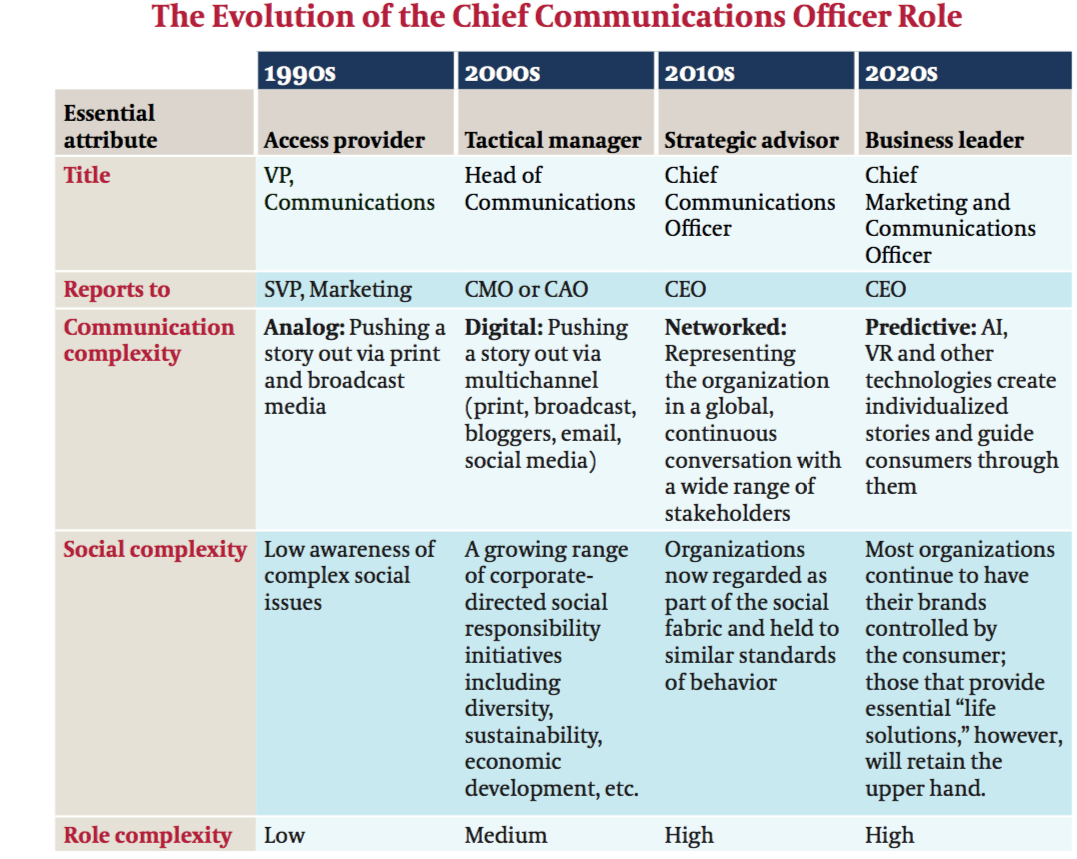Five things communications leaders need to know to stay relevant
The rapid elevation of communications leadership has given many practitioners a seat at the table but has left them to fill the role without a guidebook. Looking at how the top communications spot has changed since the 1990s – and what its trajectory might look like into the next decade – shows just how extensive this change has been. It also underscores the two factors that have driven this transformation: Increase complexity in communications technology and platforms, and increased complexity in the relationship between organizations and society at large (see table).

Because communications platforms and the relationship between business and society will continue to evolve in rapid and unpredictable ways, communications leaders will see the expectations placed on them continue to morph. What got you here, in other words, won’t get you there. However, there are five things current and aspiring communications leaders can keep in mind as they chart a course for their organizations and themselves.
1. Communications is much more than “communications”
In an effort to stay on top of the game, one might think it’s enough to master the communications function, given its vastly increased scope. But that very scope creep is blurring the lines between it and other key areas. For example, the increasing overlap between communications and marketing today means that a good communications chief needs a solid command of branding strategy. Indeed, we are increasingly seeing the rise of the “chief marketing and communications officer.” And to take it one step further: In many organizations, communications is becoming a key driver of, rather than a support function for, business strategy. Increasingly, the most sought- after comms leaders will be those who can see a path to building businesses around their functions—and who can get the CEO to buy into that vision.
2. Increasingly, you can’t stay above the fray.
Society is more polarized and contentious than it has been in memory, with a succession of hot- button issues unexpectedly erupting at the center of public discourse. An organization’s values will be a guide to how to respond to unfolding events but will not provide cover. Communications leaders—and the CEOs they advise—may well be called on to stake out positions on issues they could have avoided in an earlier day.
3. The organization’s brand isn’t the only one to worry about
The CEO has always been the face of the enterprise. Today, however, the visibility of that face is greatly amplified by social media, books, speeches, philantrophy and public service. This gives the publicly minded CEO a much larger platform in which to build his or her brand– and more opportunity to either reinforce or detract from the organization's messaging. Communications chiefs who don't have explicit control over the CEO's communications agenda need to keep a constant eye on what is coming out of the corner office to exert the necessary influence to maximize opportunity and minimize risk.
4. Few can hold their own against vox populi
Society will continue to judge organizations on their values and actions. Even companies that provide essential “digital life solutions” (think Apple, Facebook, Google and Amazon) get no immunity from scrutiny—but they will have the upper hand in retaining control of their brand. Understand, however, that this is a position that few can hope to atain. Most organizations will continue to be made or broken by social media and public sentiment.
5. Personal qualities will count as much as technical acumen.
The speed with which the CCO role spec is changing means that while expanding one’s competencies will always be necessary, it is no longer sufficient. The best communications leaders will thrive on change rather than merely manage it—and that goes beyond technical acumen to having personal qualities like curiosity, insight, engagement and determination. (These four qualities and how they relate to leadership competencies are discussed in the detail in „Turning Potential into Success“ by my colleagues Claudio Fernández-Aráoz, Andrew Roscoe and Kentaro Aramaki in Harvard Business Review, November 2017). As the next generation of communications leaders rises through the ranks, those who hit walls in their career may have to do some soul searching to see how well-suited they are to riding a never-ending roller coaster.
This piece was also featured in PR News: What Comms Leaders Must Know to Remain Relevant





